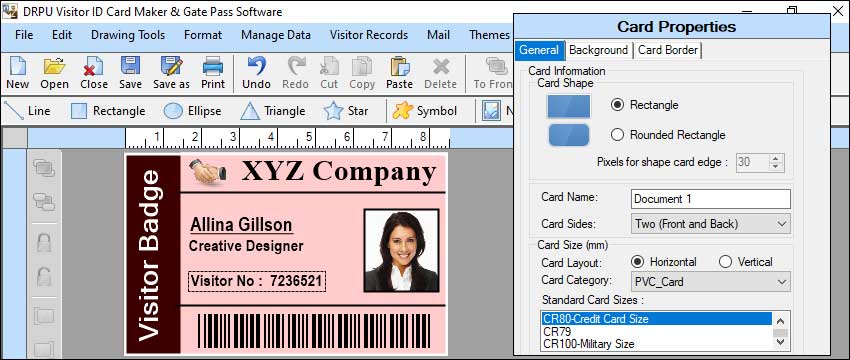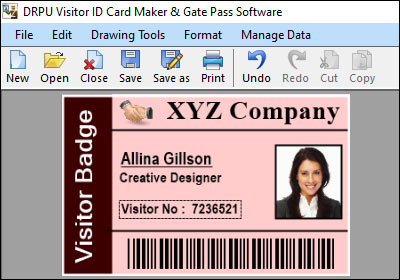Introduction of Visitor ID Card Maker
⯁ A visitor ID card maker is a tool or software that allows organizations to create and print ID cards for visitors who enter their premises. These ID cards are typically issued to guests, contractors, or other individuals who are not permanent employees of the organization but need temporary access.
⯁ The purpose of a visitor ID card is to enhance security and monitor the movement of individuals within a facility. It helps identify authorized visitors, ensures they have the necessary permissions, and allows for easy recognition by security personnel or staff members. Visitor ID cards typically include essential information such as the visitor's name, photograph, the purpose of their visit, and the dates and times of their authorized access.
Here is a step-by-step process of using a visitor ID card maker:
-
Photo Capture:
Administrators input visitor details into the software, including as the visitor's name, address, contact information, purpose of visit, and any additional other information required by the organization.
-
Printing:
Once the ID card design is finalized, the software generates a printable file. This file can be sent to a connected printer or exported for professional printing. Some ID card makers also support integration with card printers for direct printing.
-
Card Issuance:
The printed ID cards are distributed to visitors upon their arrival at the organization's premises. Security personnel or receptionists typically handle this process and may require visitors to wear or prominently display the ID card during their stay.
-
Card Design:
The software may offer the option to capture a photograph of the visitor using a webcam or by uploading an existing photo. This image will be printed on the ID card Maker software.
-
Data Entry:
The administrator selects a template or creates a custom design for the ID card. This includes choosing the layout, font styles, colors, and any organization-specific logos or graphics.
In addition to creating ID cards, some visitor ID card makers offer additional features like visitor registration, badge scanning, visitor sign-in/sign-out processes, and integration with visitor management systems. These features streamline the overall visitor management process, enhance security measures, and provide valuable insights into visitor data.
Overall, a visitor ID card maker simplifies the creation and issuance of ID cards for visitors, helping organizations maintain security, identify authorized individuals, and track visitor movement within their premises.
Several Benefits of Visitor ID Card Maker for Organizations
Using a visitor ID card maker offers several benefits for organizations. Here are some of the key advantages:

-
01 Enhanced
Security:
Implementing visitor ID cards improves overall security by allowing easy identification of authorized visitors. The cards provide a visual cue to staff and security personnel that a person has been granted access to the premises. This helps identify individuals who may not have a legitimate reason to be on-site, reducing the risk of unauthorized entry or potential security breaches.
-
02
Efficient Visitor Management:
A visitor ID card maker simplifies the visitor management process. It allows organizations to quickly capture visitor information, generate ID cards, and track visitor activity. This streamlines the check-in/check-out procedures, reducing waiting times and improving overall efficiency.
-
03
Professional Image:
Visitor ID cards contribute to a more professional and organized image of an organization. When visitors are provided with a well-designed and branded ID card, it instills confidence and trust in the organization's security measures and attention to detail. It also reflects positively on the organization's commitment to visitor safety and compliance.
-
04
Customization and Branding:
Visitor ID card makers offer customization options, allowing organizations to design ID cards that align with their branding and security requirements. This includes incorporating the organization's logo, colors, and any other specific elements that represent its identity. Customization enhances the professional appearance of the ID cards and reinforces the organization's brand image.
-
05 Visitor
Tracking and Reporting:
Many visitor ID card makers come with built-in visitor management systems or integrate with such systems. These systems enable organizations to track visitor data, including entry and exit times, purpose of visit, and other relevant information. This data can be valuable for security audits, compliance reporting, or visitor analytics. It helps organizations identify patterns, optimize resource allocation, and make informed decisions regarding visitor access policies.
-
06 Easy
Card Reissuing:
In the case of lost or stolen ID cards, a visitor ID card maker simplifies the process of reissuing new cards. Administrators can easily retrieve visitor information from the system and quickly generate replacement cards, ensuring minimal disruption for visitors and maintaining security protocols.
-
07 Regulatory
Requirements:
Depending on the industry or organization type, there may be specific compliance or regulatory requirements regarding visitor identification and access control. A visitor ID card maker can assist in meeting these requirements by ensuring that all necessary information is captured and displayed on the ID cards.
-
08
Integration and Scalability:
Many visitor ID card makers offer integration capabilities with other systems such as access control systems, visitor management platforms, or employee databases. This allows for seamless data synchronization, centralized management, and improved overall security infrastructure. Additionally, the scalability of visitor ID card makers ensures that organizations can handle increasing visitor volumes without compromising efficiency or security.
By leveraging a visitor ID card maker, organizations can streamline their visitor management processes, enhance security measures, maintain a professional image, and comply with regulatory requirements. These benefits contribute to a safer, more organized, and efficient environment for both visitors and the organization itself.
Information should be included on a visitor ID card Maker
A visitor ID card typically contains essential information to identify and verify the identity of the visitor. Each visitor ID card should have a unique identification number or barcode. This number helps in tracking and managing visitor records, especially in situations where multiple visitors are present simultaneously. While specific requirements may vary depending on the organization and purpose of the visit, here are the common details that should be included on a visitor ID card:
-
Visitor's Full Name:
The visitor's complete name, including first name and last name, should be prominently displayed on the ID card. This helps in identifying the individual quickly and accurately.
-
Visitor's Photograph:
A recent photograph of the visitor should be included on the ID card. This provides a visual reference for security personnel and helps ensure that the person carrying the card matches the photo.
-
Visitor's Signature:
It is common to have a space on the ID card where the visitor can sign their name. This allows for verification of the visitor's identity through a signature match if necessary.
-
Date of Issue:
The date the ID card is issued is important for tracking the duration of the visit. It helps determine if the visitor's access is still valid and provides a reference point for security purposes.
-
Company or Organization:
If the visitor is representing a company or organization, their affiliation should be mentioned on the ID card. This assists in identifying the visitor's association and establishing their legitimacy.
-
Purpose of Visit:
Including the purpose of the visit can be useful for security personnel and staff members. It helps them understand the visitor's intentions and determine if they have legitimate reasons to be on the premises.
-
Host Information:
The name or identification of the person or department responsible for the visitor's invitation or supervision should be provided. This facilitates contact between the visitor and their host and helps ensure accountability during their stay.
-
Expiry Date:
An expiry date should be clearly indicated on the ID card. This date represents the end of the visitor's authorized access and serves as a security measure to prevent unauthorized access after the designated period.
-
Security Features:
To enhance the security of the ID card, various features such as holograms, watermarks, or security patterns can be incorporated. These features help deter counterfeiting or tampering and assist in quick visual identification.
It's important to note that the specific requirements for visitor ID cards can vary based on the organization's security policies and industry regulations. Some organizations may have additional information or specific formats for their ID cards to meet their unique needs.
